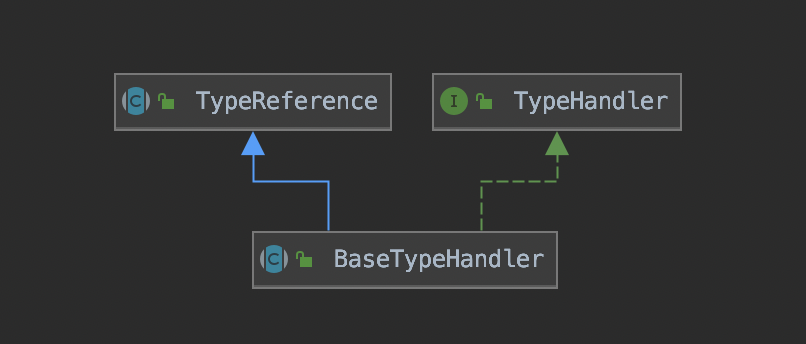概述
JDBC数据类型与Java语言中的数据类型并不是完全对应的,所以在PreparedStatement为SQL语句绑定参数时,需要从Java类型转换成JDBC类型,而从结果集中获取数据时,则需要从JDBC类型转换成Java类型。Mybatis使用类型处理器完成上述两种转换。
在Mybatis中使用JdbcType这个枚举类型代表JDBC中的数据类型,该枚举类型中定义了TYPE_CODE字段,记录了JDBC类型在java.sql.Types中相应的常量编码,并通过一个静态集合codeLookup维护了常量编码与JdbcType之间的对应关系。
TypeHandler
Mybatis中所有的类型转换器都实现了TypeHandler接口,在TypeHandler接口中定义了如下四个方法,这四个方法分为两类:setParameter()方法负责将数据由JdbcType类型转换成Java类型;getResult()及其重载负责将数据由Java类型转换成JdbcType类型。
public interface TypeHandler<T> {
// 使用PreparedStatement为SQL语句绑定参数,会调用此函数
void setParameter(PreparedStatement ps, int i, T parameter, JdbcType jdbcType) throws SQLException;
/**
* Gets the result.
*
* @param rs
* the rs
* @param columnName
* Colunm name, when configuration <code>useColumnLabel</code> is <code>false</code>
* @return the result
* @throws SQLException
* the SQL exception
*/
// 从ResultSet中获取数据时,会调用此函数
T getResult(ResultSet rs, String columnName) throws SQLException;
T getResult(ResultSet rs, int columnIndex) throws SQLException;
T getResult(CallableStatement cs, int columnIndex) throws SQLException;
}
为了方便实现,Mybatis提供了BaseTypeHandler这个抽象类,它实现了TypeHandler接口,并继承了TypeReference抽象类,结构如下:

在BaseTypeHandler中实现了TypeHandler.setParameter()方法和TypeHandler.getResult()方法,如下所示:
@Override
public void setParameter(PreparedStatement ps, int i, T parameter, JdbcType jdbcType) throws SQLException {
if (parameter == null) {
if (jdbcType == null) {
throw new TypeException("JDBC requires that the JdbcType must be specified for all nullable parameters.");
}
try {
// 如果参数为null,则调用PreparedStatement的setNull方法设置null值。
ps.setNull(i, jdbcType.TYPE_CODE);
} catch (SQLException e) {
throw new TypeException("Error setting null for parameter #" + i + " with JdbcType " + jdbcType + " . "
+ "Try setting a different JdbcType for this parameter or a different jdbcTypeForNull configuration property. "
+ "Cause: " + e, e);
}
} else {
try {
// 设置非空参数,该抽象方法由子类实现
setNonNullParameter(ps, i, parameter, jdbcType);
} catch (Exception e) {
throw new TypeException("Error setting non null for parameter #" + i + " with JdbcType " + jdbcType + " . "
+ "Try setting a different JdbcType for this parameter or a different configuration property. "
+ "Cause: " + e, e);
}
}
}
@Override
public T getResult(ResultSet rs, String columnName) throws SQLException {
try {
return getNullableResult(rs, columnName);
} catch (Exception e) {
throw new ResultMapException("Error attempting to get column '" + columnName + "' from result set. Cause: " + e, e);
}
}
@Override
public T getResult(ResultSet rs, int columnIndex) throws SQLException {
try {
return getNullableResult(rs, columnIndex);
} catch (Exception e) {
throw new ResultMapException("Error attempting to get column #" + columnIndex + " from result set. Cause: " + e, e);
}
}
@Override
public T getResult(CallableStatement cs, int columnIndex) throws SQLException {
try {
return getNullableResult(cs, columnIndex);
} catch (Exception e) {
throw new ResultMapException("Error attempting to get column #" + columnIndex + " from callable statement. Cause: " + e, e);
}
}
一般情况下,TypeHandler用于完成单个列值的类型转换,如果存在多列值转换成一个Java对象的需求,应该优先考虑使用在映射文件中定义合适的映射规则完成映射。
TypeHandlerRegistry
在Mybatis初始化过程中,会为所有已知的TypeHandler创建对象,并实现注册到TypeHandlerRegistry中,由TypeHandlerRegistry负责管理这些TypeHandler对象。
核心字段如下含义:
// 记录JdbcType与TypeHandler之间的对应关系,其中JdbcType是一个枚举类型,它定义对应的JDBC类型
// 该集合主要用于从结果集读取数据时,将数据从JDBC类型转换成Java类型
private final Map<JdbcType, TypeHandler<?>> jdbcTypeHandlerMap = new EnumMap<>(JdbcType.class);
// 记录了Java类型向指定JdbcType转换时,需要使用的TypeHandler对象。
private final Map<Type, Map<JdbcType, TypeHandler<?>>> typeHandlerMap = new ConcurrentHashMap<>();
// 记录了全部的TypeHandler的类型及TypeHandler对象
private final Map<Class<?>, TypeHandler<?>> allTypeHandlersMap = new HashMap<>();
// 空TypeHandler集合的标识
private static final Map<JdbcType, TypeHandler<?>> NULL_TYPE_HANDLER_MAP = Collections.emptyMap();
1、注册TypeHandler对象
TypeHandlerRegistry.register()方法实现了注册TypeHandler对象的功能,该注册过程会向上述四个集合中添加TypeHandler对象。register()方法有多个重载。
private void register(Type javaType, JdbcType jdbcType, TypeHandler<?> handler) {
if (javaType != null) {
Map<JdbcType, TypeHandler<?>> map = typeHandlerMap.get(javaType);
if (map == null || map == NULL_TYPE_HANDLER_MAP) {
map = new HashMap<>();
}
map.put(jdbcType, handler);
typeHandlerMap.put(javaType, map);
}
allTypeHandlersMap.put(handler.getClass(), handler);
}
2、查找TypeHandler
getTypeHandler方法如下:
private <T> TypeHandler<T> getTypeHandler(Type type, JdbcType jdbcType) {
if (ParamMap.class.equals(type)) {
return null;
}
Map<JdbcType, TypeHandler<?>> jdbcHandlerMap = getJdbcHandlerMap(type);
TypeHandler<?> handler = null;
if (jdbcHandlerMap != null) {
handler = jdbcHandlerMap.get(jdbcType);
if (handler == null) {
handler = jdbcHandlerMap.get(null);
}
if (handler == null) {
// #591
handler = pickSoleHandler(jdbcHandlerMap);
}
}
// type drives generics here
return (TypeHandler<T>) handler;
}
最后,除了Mybatis本身提供的TypeHandler实现,我们也可以添加自定义的TypeHandler接口实现,添加方式是在mybatis-config.xml配置文件中的
